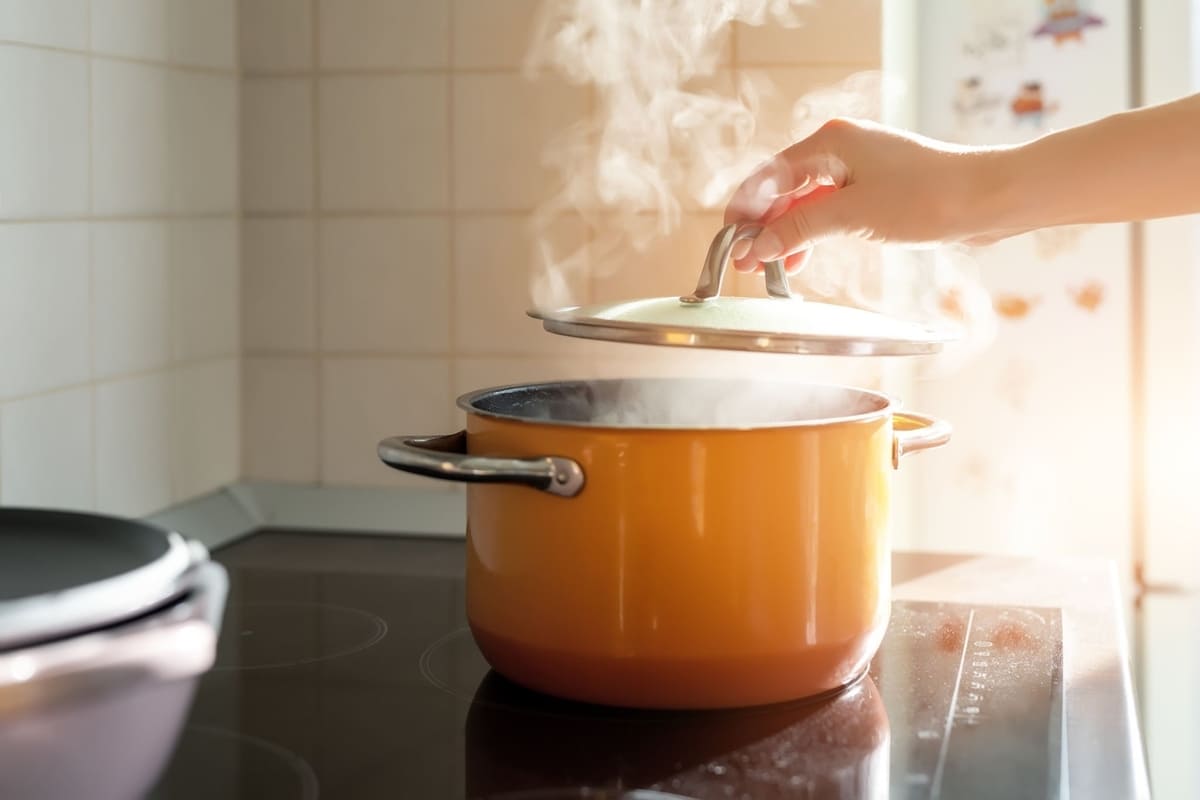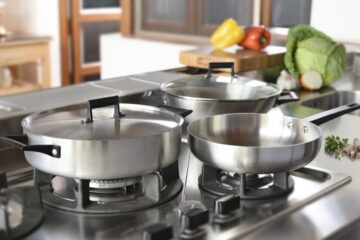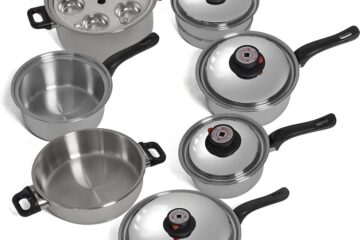When it comes to cooking, choosing the right cookware is just as important as selecting the right ingredients. The type of cookware you use can have a significant impact on your health, as some materials can potentially leach harmful chemicals or metals into your food. Therefore, it’s essential to know which cookware is safe and healthy to use.
There are several types of cookware available on the market, including stainless steel, cast iron, ceramic, and non-stick. Each type has its pros and cons, and some are safer than others. For instance, non-stick cookware is convenient, but it can release toxic fumes when overheated. On the other hand, cast iron cookware is durable and can add iron to your diet, but it requires seasoning and can be heavy to handle. In this article, we will explore the safest cookware options available and what to look for when choosing cookware for your health.
Understanding Cookware Materials
When it comes to choosing cookware, there are several materials to consider. Each material has its own unique properties that can affect the safety of the cookware. Here are some of the most common cookware materials and what you need to know about them.
Cast Iron
Cast iron is a popular choice for cookware due to its durability and versatility. Cast iron cookware is made by pouring molten iron into a mold, which is then cooled and polished. Cast iron is a good conductor of heat, which means that it heats evenly and retains heat well.
One thing to keep in mind when using cast iron cookware is that it can be reactive with acidic foods, such as tomatoes or vinegar. This can cause the cookware to leach iron into the food, which can be beneficial for some people but may be harmful for others. To avoid this, it’s best to avoid cooking acidic foods in cast iron or to use a well-seasoned cast iron pan.
Stainless Steel
Stainless steel is a popular choice for cookware due to its durability and non-reactive properties. Stainless steel is made by combining steel with other metals, such as chromium and nickel, which gives it its non-reactive properties.
Stainless steel is a poor conductor of heat, which means that it can have hot spots and take longer to heat up. To avoid this, look for stainless steel cookware that has a copper or aluminum core, which will help it heat more evenly.
Copper
Copper is a good conductor of heat, which means that it heats evenly and quickly. Copper cookware is often lined with another metal, such as stainless steel or tin, to prevent it from reacting with acidic foods.
One thing to keep in mind when using copper cookware is that it can be expensive and requires more maintenance than other types of cookware. Copper cookware needs to be polished regularly to maintain its shine, and the lining may need to be replaced over time.
Aluminum
Aluminum is a good conductor of heat, which means that it heats evenly and quickly. However, aluminum can react with acidic foods, which can cause the cookware to leach aluminum into the food.
To avoid this, look for aluminum cookware that has a non-reactive coating, such as anodized aluminum. Anodized aluminum has been treated with an electrochemical process that creates a hard, non-reactive surface.
Understanding Cookware Materials
When it comes to choosing cookware, it’s essential to consider the material it’s made from. Different materials have different properties and can affect the taste and safety of your food. Here are some common cookware materials:
Cast Iron
Cast iron cookware is a popular choice for many home cooks. It’s durable, retains heat well, and can be used on the stovetop or in the oven. Cast iron is also naturally non-stick when seasoned properly. However, it can be heavy and requires maintenance to prevent rust.
Stainless Steel
Stainless steel cookware is known for its durability and resistance to corrosion and staining. It’s a popular choice for professional kitchens and home cooks alike. Stainless steel is also non-reactive, meaning it won’t interact with acidic foods. However, it’s not the best conductor of heat, so it can take longer to heat up and cool down.
Copper
Copper cookware is a favorite among professional chefs due to its excellent heat conductivity. It heats up quickly and evenly, making it ideal for cooking delicate foods. However, copper can react with acidic foods, causing a metallic taste. Copper cookware is also expensive and requires regular polishing to maintain its shine.
Aluminum
Aluminum is a lightweight and affordable cookware material. It’s an excellent conductor of heat, making it ideal for cooking evenly. However, aluminum can react with acidic foods, causing discoloration and a metallic taste. It’s also not as durable as other materials and can warp or scratch easily.
The Pros and Cons of Each Material
When it comes to choosing cookware, there are a variety of materials to choose from. Each material has its own set of pros and cons that should be considered before making a decision.
Cast Iron
Cast iron is a popular choice for cookware due to its durability and versatility. It is also a great option for those looking for a non-toxic cookware option. However, it is important to note that cast iron can be heavy and may require seasoning to prevent rusting.
Pros:
- Durable
- Versatile
- Non-toxic
- Retains heat well
Cons:
- Heavy
- Requires seasoning
- Can rust if not properly cared for
Stainless Steel
Stainless steel is a popular choice for cookware due to its sleek appearance and ability to withstand high temperatures. It is also easy to clean and is compatible with all cooktops. However, it is not the best option for even heat distribution.
Pros:
- Sleek appearance
- High temperature resistance
- Easy to clean
- Compatible with all cooktops
Cons:
- Poor heat distribution
Copper
Copper is a great option for those looking for even heat distribution. It is also a beautiful addition to any kitchen. However, it is important to note that copper can be expensive and may require polishing to maintain its appearance.
Pros:
- Even heat distribution
- Beautiful appearance
Cons:
- Expensive
- Requires polishing
Aluminum
Aluminum is a popular choice for cookware due to its affordability and lightweight design. However, it is not the best option for those looking for a non-toxic cookware option.
Pros:
- Affordable
- Lightweight
Cons:
- Not a non-toxic option
When choosing cookware, it is important to consider the pros and cons of each material to find the best option for your needs.
Non-Toxic Cookware Options
When it comes to choosing non-toxic cookware, there are several options available. Here are some of the most popular options:
Ceramic Cookware
Ceramic cookware is a popular non-toxic option. It is made from natural materials and is free from harmful chemicals. Ceramic cookware is also durable and easy to clean. However, it can be prone to chipping and cracking if not handled carefully.
Glass Cookware
Glass cookware is another non-toxic option. It is made from natural materials and is free from harmful chemicals. Glass cookware is also non-reactive, meaning it won’t leach any chemicals or flavors into your food. However, it can be heavy and may not be suitable for all types of cooking.
Titanium Cookware
Titanium cookware is a lightweight and durable option. It is also non-reactive and free from harmful chemicals. Titanium cookware is also known for its even heat distribution, making it a good choice for cooking a variety of dishes. However, it can be expensive and may not be suitable for all types of cooking.
When choosing non-toxic cookware, it’s important to consider your cooking needs and preferences. Some other factors to consider include the material’s durability, ease of cleaning, and heat distribution. Overall, non-toxic cookware can help you create healthy and delicious meals without any harmful chemicals.
Eco-Friendly Cookware Options
When it comes to cookware, eco-friendliness is an important factor to consider. Fortunately, there are a number of options available that are not only safe for your health, but also environmentally friendly. Here are a few eco-friendly cookware options to consider:
Clay Cookware
Clay cookware is an excellent choice for those looking for an eco-friendly option. It is made from natural materials and is free from harmful chemicals. Additionally, clay cookware is excellent at retaining heat, which means you can cook your food at a lower temperature and save energy.
One thing to keep in mind is that clay cookware can be somewhat fragile, so it’s important to handle it carefully. Additionally, it is not dishwasher safe, so you’ll need to wash it by hand.
Terracotta Cookware
Terracotta is another excellent eco-friendly option. Like clay, it is made from natural materials and is free from harmful chemicals. Terracotta cookware is also excellent at retaining heat, which means you can cook your food at a lower temperature and save energy.
One thing to keep in mind is that terracotta cookware can be somewhat fragile, so it’s important to handle it carefully. Additionally, it is not dishwasher safe, so you’ll need to wash it by hand.
Soapstone Cookware
Soapstone is a type of stone that is often used for cookware. It is an excellent eco-friendly option because it is a natural material and is free from harmful chemicals. Additionally, soapstone is excellent at retaining heat, which means you can cook your food at a lower temperature and save energy.
One thing to keep in mind is that soapstone cookware can be somewhat heavy, so it’s important to handle it carefully. Additionally, it is not dishwasher safe, so you’ll need to wash it by hand.
Conclusion
When it comes to choosing the safest cookware for your health, there are several factors to consider. Non-reactive surfaces, durability, and simple designs are all important features to look for in cookware. Additionally, it is important to choose cookware made from materials that do not leach harmful chemicals or metals into your food.
Some of the safest cookware materials include titanium, ceramic, and stainless steel. These materials are durable, non-reactive, and do not contain harmful chemicals or metals. Additionally, they are easy to clean and maintain.
It is important to note that while some materials may be safer than others, no cookware is completely risk-free. It is important to always use cookware properly and to follow manufacturer instructions for cleaning and maintenance.
Overall, choosing the safest cookware for your health is a personal decision that will depend on your individual needs and preferences. By considering the factors mentioned above and doing your research, you can make an informed decision and ensure that your cookware is safe and healthy for you and your family.



